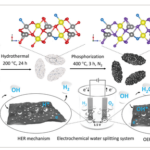多くの人にとって抽象的な概念かもしれませんが、量子力学は、鉄鋼やその他の合金を製造する際の二酸化炭素排出量を削減し、材料をより強く、より軽くする役割を果たすことが、新しい研究で明らかにされました。 It may be an abstract concept for many people, but a new study shows that quantum mechanics can play a role in reducing the carbon footprint for producing steel and other alloys while making materials stronger and lighter.
2023-02-23 スウェーデン王国・王立工科大学(KTH)
◆この研究成果は、米国科学アカデミー紀要(PNAS)の学術誌「Nexus」に掲載されました。
◆ストックホルムにあるKTH王立工科大学材料科学部のレヴェンテ・ビトス教授は、この研究により、機械的特性を向上させた耐食性オーステナイト系ステンレス鋼など、新しい種類の構造材料の創製が可能になると述べています。
◆より強く、より軽い、より可鍛性の高い合金の研究開発において、何がそのような有利な特性をもたらすかを正確に判断することは必ずしも容易ではなかった、とヴィトス教授は言う。それは、合金を製造する際の原子や分子のプロセスを考慮した開発が行われていないためです。
◆KTHの研究者たちは、量子論に基づく設計手法を新しい鋼鉄合金に適用し、硬化メカニズムが原子レベルで見えるようにした。
◆共同研究者のSong Lu氏によれば、この新しい研究により、新しい種類の構造材料のカスタマイズや最適化に最適な合金の組み合わせを特定することが可能になるという。そして、これは環境にとっても良いニュースだという。
◆「構造材料の機械的特性が向上すれば、軽量化や原材料の削減が可能になり、より持続可能な社会の実現に必要な省エネルギーの目標に貢献することができます」と、Luは語っている。
<関連情報>
- https://www.kth.se/en/om/nyheter/centrala-nyheter/kvantteori-bakom-nya-starka-metallegeringar-1.1229877
- https://academic.oup.com/pnasnexus/article/2/1/pgac282/6881734
変形を媒介とした双子化理論 Theory of transformation-mediated twinning
Song Lu, Xun Sun, Yanzhong Tian, Xianghai An, Wei Li, Yujie Chen, Hualei Zhang, Levente Vitos
PNAS Nexus Published:07 December 2022
DOI:https://doi.org/10.1093/pnasnexus/pgac282

Abstract
High-density and nanosized deformation twins in face-centered cubic (fcc) materials can effectively improve the combination of strength and ductility. However, the microscopic dislocation mechanisms enabling a high twinnability remain elusive. Twinning usually occurs via continuous nucleation and gliding of twinning partial dislocations on consecutive close-packed atomic planes. Here we unveil a completely different twinning mechanism being active in metastable fcc materials. The transformation-mediated twinning (TMT) is featured by a preceding displacive transformation from the fcc phase to the hexagonal close-packed (hcp) one, followed by a second-step transformation from the hcp phase to the fcc twin. The nucleation of the intermediate hcp phase is driven by the thermodynamic instability and the negative stacking fault energy of the metastable fcc phase. The intermediate hcp structure is characterized by the easy slips of Shockley partial dislocations on the basal planes, which leads to both fcc and fcc twin platelets during deformation, creating more twin boundaries and further enhancing the prosperity of twins. The disclosed fundamental understanding of the complex dislocation mechanism of deformation twinning in metastable alloys paves the road to design novel materials with outstanding mechanical properties.



